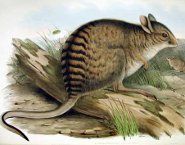 Australia is home to some of the rarest animals in the world, including the munning or banded hare-wallaby (Lagostrophus fasciatus). If the names are unfamiliar, this may be due to the animal’s extreme rarity. It is found on two tiny islands off Australia’s western coast, Bernier Island and Dorre Island. Its original range went in large patches of the Australian west. After European colonists arrived, they brought with them their beloved domestic cats. In those days, cats were allowed to roam at will and were not kept indoors.
Australia is home to some of the rarest animals in the world, including the munning or banded hare-wallaby (Lagostrophus fasciatus). If the names are unfamiliar, this may be due to the animal’s extreme rarity. It is found on two tiny islands off Australia’s western coast, Bernier Island and Dorre Island. Its original range went in large patches of the Australian west. After European colonists arrived, they brought with them their beloved domestic cats. In those days, cats were allowed to roam at will and were not kept indoors.Unfortunately, the banded hare-wallaby could not defend itself against such a skilled hunter. They also need to feed on natural grasses, which were destroyed in vast quantities by the European colonists in order to grow their food and livestock. Under this double pressure, the banded hare-wallaby was wiped out on the mainland by 1906.
Physical Description
The banded hare-wallaby resembles a very small, striped kangaroo. When it was first seen by Europeans, they mistakenly thought it was a kind of raccoon. The creature has a very small, doe-shaped head in proportion to the enormous round hindquarters and long, mostly hairless tail. The short fur varies in color with stripes or spots of yellow, grey, black and dark brown. The darkest and thickets stripes are on the hindquarters. The animal is darker on the back and sides than on the belly and chest.
Adult females are slightly heavier than males. Females weigh 6.61 pounds (3 kilograms) while males only weigh 5.51 pounds (2.5 kilograms.) Both males and females grow to the same nose to tail-tip length of 31.49 inches (800 millimeters.) The tails are about the same length as the bodies.
Life Cycle and Behavior
Banded hare-wallabies are nocturnal. During the day, they sleep in long, shallow nests called runs made under scrub brush or thickets. Small colonies of banded hare-wallabies will sleep in the same run. When night falls, the little marsupials hop out to feed on whatever vegetation they can find. They prefer grasses, fruits and shrubs.
Males become aggressive to other banded hare-wallabies during the long breeding season, which runs from December to September. This period can change depending if there has been a drought that year. Females usually do not have their first offspring until they are two. Males can breed at one year of age but usually cannot due to older, stronger males in the territory. The exact gestation length for banded hare-wallabies is unknown, but females nurse their young for six months. The one or two babies in each litter leave their parents’ protection when they are about 10 months old.
Drawing of the banded hare-wallaby in 1853 from the book by John Gould, F.R.S., Mammals of Australia, Vol. II Plate 60, London, 1863.
The Banded hare-wallaby, munning is listed as Vulnerable (VU), considered to be facing a high risk of extinction in the wild, on the IUCN Red List of Threatened Species
Countries
AustraliaSome facts about the
Banded hare-wallaby
Adult weight : 2.1 kg (4.62 lbs)
Female maturity :365 days
Male maturity : 365 days
Weaning : 270 days
Litter size : 1
Interval between litters : 365 days
Weight at weaning : 0.9 kg (1.98 lbs)

Custom Search